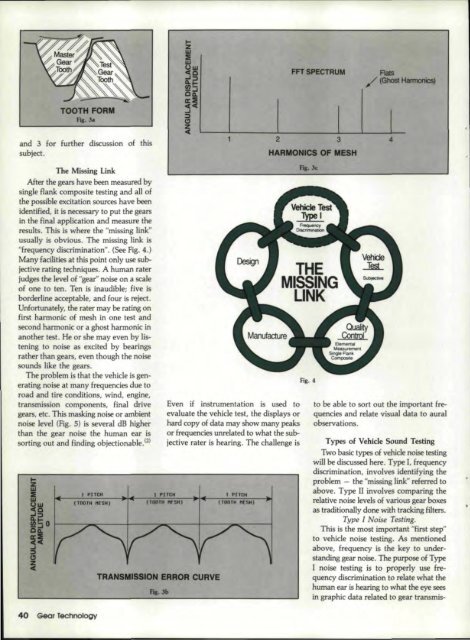Download PDF - Gear Technology magazine
Download PDF - Gear Technology magazine
Download PDF - Gear Technology magazine
Create successful ePaper yourself
Turn your PDF publications into a flip-book with our unique Google optimized e-Paper software.
FFT SPECTRUM<br />
FIaIs<br />
/ (Ghost Harmonics)<br />
TOOTH<br />
FORM<br />
F1a.3a<br />
and 3 Ior further discussion .of this<br />
subject.<br />
The Missmg Link<br />
After the gears have been measured by<br />
single flank composite testing and all of<br />
the possible excitation sources have been<br />
identified, it is necessary to,put the gears<br />
in the final application and measure the<br />
results. This is where the "missing link"<br />
usualJIy is obvious. The missing link is<br />
"frequency discrimination". (See Fig. 4.)<br />
Many facilities at this point only use subiective<br />
rating techniques. A human. rater<br />
judges the level of "gear" noise ona scale<br />
of one to 'ten. Ten is inaudible; five is<br />
borderline acceptable, and four is,reject,<br />
Unfortunately, the rater may be rating on<br />
first harmonic of mesh in one test and<br />
second harmonic or a ghost harmonic in<br />
another test ..He or she may even by listening<br />
to noise as excited by bearings<br />
rather than gears, even though the noise<br />
sounds like the gears ..<br />
The problem is that the vehicle is generating<br />
noise at many frequencies due to<br />
road and tire conditions, wind, engine,<br />
transmission components, final drive<br />
gears, etc. This masking noise or ambient<br />
noise level (Fig. 5) is several dB, higher<br />
than the gear noise the human ear is<br />
sorting out and finding objectionable ..(Zl<br />
40 <strong>Gear</strong> <strong>Technology</strong><br />
TRANSMISSION<br />
I PITCH<br />
(TOOTH ftfStU<br />
FIg.3b<br />
1 2 3 4<br />
HARMONICS<br />
Even if instrumentation is used to<br />
evaluate the vehicle test, the displays or<br />
hard copy of data may show many peaks<br />
or frequencies unrelated to what the subjective<br />
rater is hearing. The challenge is<br />
ERROR CURVE<br />
I PITCH<br />
(TOOTH "E8H)<br />
Fis,3c<br />
Fig. 4<br />
OF MESH<br />
to be able to sort out the important frequencies<br />
and relate visual data to aural<br />
observations.<br />
Types of Vehide Sound Testing<br />
Two basic types of vehicle noise testing<br />
will be discussed here. Type t frequency<br />
disc.nmination, involves identifying the<br />
problem - the "missing link" referrul. to<br />
above. Type II involves comparing the<br />
relative noise levels of various gear boxes<br />
as traditionally done 'With tracking filters ..<br />
Type 1 Noise Testing.<br />
Thjs is 'the most important "first step'"<br />
to vehicle noise testing. As mentioned<br />
above, fllequency is the key to understanding<br />
gear noise. The purpose oE Type<br />
I noise testing is to properly use frequency<br />
discri_mination to' relate what the<br />
human ear is hearing to what the eye sees<br />
in graphic data related to gear transmis-

















